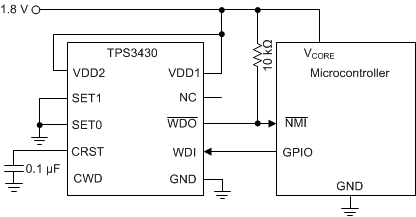SBVS366A July 2018 – October 2021 TPS3430
PRODUCTION DATA
- 1 Features
- 2 Applications
- 3 Description
- 4 Revision History
- 5 Pin Configuration and Functions
- 6 Specifications
- 7 Detailed Description
- 8 Application and Implementation
- 9 Power Supply Recommendations
- 10Layout
- 11Device and Documentation Support
- 12Mechanical, Packaging, and Orderable Information
8.2.2 Monitoring Microcontroller with a Programmed Window Watchdog Timer - Design 2
A typical application for the TPS3430 is shown in Figure 8-8. The TPS3430 is used to monitor the activity of the microcontroller via the WDI pin.
 Figure 8-8 Monitoring Microcontroller Using a Window Watchdog Timer with Programmable Watchdog Reset Delay
Figure 8-8 Monitoring Microcontroller Using a Window Watchdog Timer with Programmable Watchdog Reset Delay